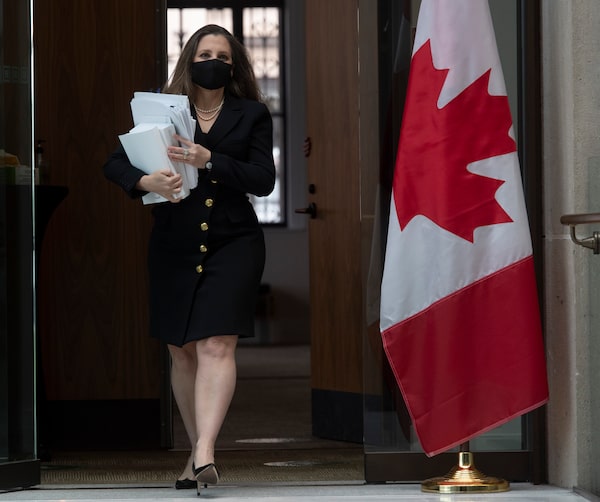
Finance Minister Chrystia Freeland walks to a news conference in Ottawa on April 19, budget day.Adrian Wyld/The Canadian Press
The Liberal government’s first budget in more than two years maintains heavy spending to combat the pandemic and aims to address social inequality while spurring economic growth – directing $101.4-billion in stimulus at key voting blocks as a potential election looms.
In unveiling her first budget, Finance Minister Chrystia Freeland is offering billions of dollars of federal money to women, seniors, students, Indigenous and racialized communities, small-business owners and young people wanting to buy their first homes.
“We must punch our way out of the COVID recession,” Ms. Freeland told a near-empty House of Commons Monday. “Our country cannot prosper if we leave hundreds of thousands behind.”
Child care, housing, jobs recovery - everything you need to know
For this generation of Liberals, government’s role is to do everything within its reach
Liberals bet big that we can spend our way out of deficit problems
After decades of Liberal pledges to create a national child-care program, the funding announced in the budget is substantial: $30-billion over the next five years and $8.3-billion annually thereafter. Ottawa expects this would cover half the cost of a national subsidized program that offers $10-a-day child care. The plan would require negotiation and equal funding from the provinces.
Some of the other major new spending announcements in the budget include $18-billion for Indigenous communities, $20-billion in enhanced support programs for workers, $12-billion to extend wage and rent subsidies for employers until September and $3-billion to improve long-term care.
Ms. Freeland said Ottawa is prepared to spend even more if the COVID-19 pandemic persists into the fall.
“This virus has proven to be very unpredictable and no one knows for sure what the course of the virus and new variants will be,” Ms. Freeland told reporters. “That is why we are prepared to act further [if required].”
Personal finance columnist Rob Carrick outlines the federal budget’s plans for discounted child care, money for seniors and extending the interest-free period for student loans. But the budget is light on details on how Ottawa will pay for pandemic recovery measures and what it will do to cool the housing market.
The document is packed with smaller spending announcements targeted at specific segments of the population.
“It looks like a pre-election budget, with all the scattered spending,” said Fred O’Riordan, a former senior Canada Revenue Agency official and now a tax-policy expert at EY Canada.
Ms. Freeland’s pitch to Canadians is that major new social spending in areas such as child care and affordable housing will prove to be good economics, creating new jobs and boosting work-force participation rates.
Stronger-than-expected economic growth over the winter delivered tens of billions in new tax revenue to the federal bottom line, allowing the Liberals to lower the projected size of the 2020-21 federal deficit from $381.6-billion to $354.2-billion.
The deficit is expected to be higher than forecast for the current fiscal year, however, as $49.3-billion in new budget spending far outweighed the gain in projected tax revenues. The federal government now forecasts a $154.7-billion deficit this year, compared with the government’s November estimate of $121.2-billion.
The spike in tax revenue because of stronger projected growth – based on an average from private-sector economists – leaves Ms. Freeland with a message that simultaneously argues that the economy is “roaring back,” yet still needs $100-billion in stimulus.
“Some will say our sense of urgency is misplaced,” she said in an opening statement in the budget. “To them, I ask this: ‘Did you lose your job during a COVID lockdown?’ "
Ms. Freeland said the stimulus is needed because the impact of the pandemic was uneven, hitting women, youth, low-wage workers and small-business owners particularly hard.
The budget includes a fiscal anchor, which focuses on the trendline of federal finances but does not include a specific target for eliminating the deficit. Rather, Ottawa says “the government is committed to unwinding COVID-related deficits and reducing the federal debt as a share of the economy over the medium term.”
By the end of the budget’s five-year projections, the government estimates that the federal deficit will have declined to $30.7-billion in 2025-26. However, the federal debt as a percentage of GDP is projected to peak at 51.2 per cent this year before declining slightly to 49.2 per cent in five years.
The spike in federal debt – from $721.4-billion before the pandemic to more than $1.2-trillion this fiscal year – has prompted some to express concern that large stimulus spending is excessive and foots future generations with the bill in terms of higher debt-servicing costs.
Ms. Freeland pushed back against that view.
“In today’s low-interest-rate environment, not only can we afford these investments in Canada’s future, it would be short-sighted of us not to make them,” she wrote.
With the country mired in a deadly third wave of the pandemic, the budget will extend wage and rent subsidies to Sept. 25 at a cost of more than $12-billion and flexible access to employment insurance will stay in place until the fall of 2022.
For youth, Ottawa will double the Canada student grant for two more years and extend the waiver of interest on federal student loans until March, 2023.
By far the most expensive measure in the budget is a promised national child-care program that will require negotiations with the provinces. Ottawa is promising to spend $30-billion in the first five years and $8.3-billion every year thereafter.
“Five years from now, parents across the country should have access to high-quality early learning and child care, for an average $10 a day,” Ms. Freeland said to the House. “We will get it done.”
The Liberal minority government is unlikely to fall on this budget because the NDP says it will not force an election during a pandemic. A vote in the fall is a distinct possibility, however, especially if Canadians are fully vaccinated by September as promised by Prime Minister Justin Trudeau.
Conservative Leader Erin O’Toole called the budget “an out-of-control debt plan without any real stimulus.” He said the budget will not protect jobs and fails to answer the call of provinces for more COVID-19 vaccines.
Bloc Leader Yves-François Blanchet said the pandemic is a health crisis, yet the budget failed to increase federal health transfers to the provinces.
NDP Leader Jagmeet Singh said the government should have listened to his party’s call for significant new taxes on the ultrarich and corporations. He said the budget’s child-care plan looks good, but said Canadians have been hearing such promises from the Liberals for decades.
“We’re going to fight to make sure this actually happens,” he said.
Economist Armine Yalnizyan, an Atkinson Fellow and a prominent advocate for national child care, was effusive Monday over the budget’s funding for child care.
“I think it would have been impossible to get here without a female finance minister,” she said. “We finally have, historically, somebody who is in charge who realizes that this is a macroeconomic issue. … This is a legacy piece of policy work whose time has finally come.”
Canadian Chamber of Commerce President Perrin Beatty lauded the government for extending wage and rental subsidies until September, as well as the small-business measures, but expressed concern about massive spending that depends on economic growth to return to a balanced budget.
“If growth doesn’t materialize as anticipated, then what we will see is the deficit and debt rise very sharply,” he said.
The word “infrastructure” appears 150 times in the budget document, but the plan outlined Monday is far removed from the heavy emphasis on bridges, roads and “shovel-ready” projects that dominated the Harper government’s stimulus plan after the 2008-09 financial crisis.
There is more money for public transit and $491.2-million over six years to support Via Rail’s plan for high-frequency rail between Quebec City and Toronto, but the budget continues the government’s practice of stretching the traditional definition of infrastructure.
The budget plan defines child care and student grants as “social infrastructure” that will generate long-term economic gains.
The latest tally of all federal measures related to the pandemic now adds up to $345.6-billion in direct support measures and $512.5-billion in credit and liquidity measures.
The most expensive single support measure has been the Canada Emergency Wage Subsidy (CEWS), which employers can use to help offset their staffing costs. The budget confirmed that the program will continue through the summer months, but the size of the maximum benefit will decline over that period.
In total, the government expects the final price tag of CEWS will be $110.5-billion.
The Canada Emergency Rent Subsidy and Lockdown Support will also continue through the summer at declining rates, with a final expected cost to government of $8.4-billion.
A new Canada Recovery Hiring Program will run from June to November as an alternative to the CEWS.
On climate change, the budget contains a large number of incentive programs aimed at boosting investment and manufacturing in clean-tech projects. A new program offering interest-free loans for energy retrofits will cost $779-million and will launch this summer for homeowners and landlords. The government expects more than 200,000 households will use the program.
The 2021 federal budget will continue economic support for businesses and individuals through the summer with a roadmap to wind them down later in the year as more Canadians are vaccinated against COVID-19.
The Globe and Mail
Know what is happening in the halls of power with the day’s top political headlines and commentary as selected by Globe editors (subscribers only). Sign up today.
 Bill Curry
Bill Curry Robert Fife
Robert Fife